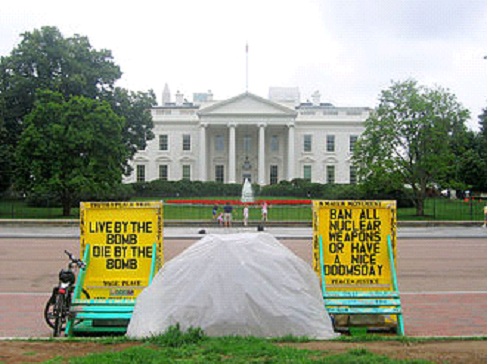Prevent a New Nuclear Arms Race: Replace the New START Treaty
by John Whitehead
The New Strategic Arms Reduction Treaty (New START) is the last significant nuclear arms control agreement that is still in effect between the United States and Russia. New START will expire in a matter of months, on February 5, 2026. Once New START is gone, the door would be open for the United States and Russia to build unlimited numbers of nuclear weapons, in a dangerous new arms race.
An opportunity exists to avert the threat of a renewed nuclear arms race, though. The United States and Russia can agree to abide by the restrictions of New START even after the treaty formally expires. Such an agreement can then be followed by negotiations for a new arms control treaty to replace the expired New START.
Preserving restraints on US and Russian nuclear arsenals is a vitally important part of reducing the threat from nuclear weapons. Policymakers and activists should seize this chance to check an arms race.
The End of New START
In nuclear technical terminology, “strategic weapons” refers to nuclear weapons with very high levels of destructive power (or “yield”) that can be mounted on missiles or planes capable of traveling great distances. These weapons are named this way because they can inflict such significant devastation on another nation as to supposedly alter the outcome of a war. (In reality, such distinctions are artificial since any nuclear weapon, even a very low-yield, non-strategic one, is massively destructive.)
The first treaty reducing these types of nuclear weapons, the original START, was adopted by the United States and Russia (then the Soviet Union) in 1991. After START expired in 2009, it was replaced with New START, signed in 2010 by US President Barack Obama and Russian President Dmitri Medvedev.
The New START treaty restricts both Russia and the United States to having only 1,550 strategic nuclear weapons each. While it hardly eliminates the nuclear threat, New START at least places a limit on a particular category of nuclear weapons, and this limit could serve as a stepping stone to further weapons reductions in the future.
In 2021, the Biden administration arranged with the Russian government to extend New START under a provision of the treaty that allowed for a one-time, five-year extension. That extension will end next February.
If New START ends and no new arms control agreement replaces it, then the United States and Russia may opt to increase their strategic nuclear weapons beyond the limit previously set by the treaty. Such increases would waste money, make nuclear arms reductions more difficult, and potentially worsen international tensions as each nation tries to get a nuclear “advantage” over the other.
Hope for a New Arms Agreement?
A new nuclear arms race is not inevitable, though. An alternative path is possible. Earlier this year, US President Donald Trump expressed interest in holding nuclear arms control talks with both Russia and China.
Further, Russian President Vladimir Putin made a significant announcement on September 22:
[T]o prevent the emergence of a new strategic arms race and to preserve an acceptable degree of predictability and restraint…Russia is prepared to continue observing the [New START] treaty’s central quantitative restrictions for one year after February 5, 2026.
Following that date, based on a careful assessment of the situation, we will make a definite decision on whether to uphold these voluntary self-limitations. We believe that this measure is only feasible if the United States acts in a similar spirit and refrains from steps that would undermine or disrupt the existing balance of deterrence.
A specific US policy that Putin identified as a concern is the Trump administration’s decision to build an elaborate “Golden Dome” defense system meant to protect the United States from another country’s missile attacks. US missile defense systems have long been a source of anxiety for Russia. In his September 22 remarks, Putin implied that “the practical implementation” of such a system could lead Russia to abandon its commitment to the New START limitations.
Russian Foreign Minister Sergei Lavrov repeated the offer to abide by the New START limitations for another year in a September 27 address to the UN General Assembly. Lavrov emphasized that “the implementation of our proposal will create conditions for avoiding a strategic arms race” but also stressed that the United States must reciprocate and avoid disrupting the power balance between the two nations.
The Trump administration’s response to this Russian offer has been sympathetic but vague. White House Press Secretary Karoline Leavitt said on September 22 that the Russian proposal sounded “pretty good.” President Trump echoed this sentiment two weeks later, saying the proposal “sounds like a good idea to me.”
These friendly noises have yet to translate into action, though. A September 24 meeting between Lavrov and US Secretary of State Marco Rubio notably failed to produce any definite agreement on this point.
What You Can Do
American policymakers should accept the Russian offer by also agreeing to abide by New START limits for another year. The unrealistic goal of an ambitious missile defense system should not be allowed to derail such an agreement.
Moreover, agreeing to maintain the New START restrictions need not involve the politically difficult step of abandoning the Golden Dome system altogether. Putin’s word choice of “practical implementation” suggests some flexibility on this point: perhaps planning for the Golden Dome can continue without ever being translated into concrete action.
An agreement to abide by the New START limits for another year is only a stop-gap measure, though. After the United States and Russia reach such an agreement, the two nations must negotiate a new, longer-term nuclear weapons treaty. A new treaty would, at the very minimum, maintain current limits on nuclear weapons and ideally further reduce the number of weapons.
Legislation currently before the US Congress (H.Res 100/S.Res 61) calls for such a new treaty, advocating for “a dialogue with the Russian Federation on a new nuclear arms control framework.” The resolution also calls for “the United States and the Russian Federation to continue to respect the numerical constraints on the strategic deployed nuclear forces established by the New START Treaty until such time as a new nuclear arms control framework is established.”
American citizens can promote current efforts at nuclear arms control by contacting their representatives and senators to urge them to support H.Res 100/S.Res 61. The Arms Control Association provides a convenient guide to communicating with members of Congress on this issue.
Americans can also contact the Trump administration by email or phone (202-456-1111) to urge the president both to reciprocate the Russian offer to follow New START limitations for another year and to pursue further arms control negotiations with Russia.
An uncontrolled nuclear arms race between the United States and Russia would be colossally dangerous. Both countries should take action to prevent such a tragedy.
Another way to advocate against a nuclear arms race is to participate in the Consistent Life Network’s quarterly peace vigil outside the White House in Washington, DC. The next vigil will be on November 2. Please join us!
=======================================
For more of some of John Whitehead’s writings on nuclear weapons, see:
Reasons to Fear, Reasons to Hope: The Nuclear Threat after 80 Years
Persuading People to Act against the Nuclear Threat: Some Findings and Recommendations
The Persisting Threat of Nuclear Weapons: A Brief Primer
Nuclear Disarmament as a Social Justice Issue
A Global Effort to Protect Life: The UN Treaty Banning Nuclear Weapons
You can see many more posts on the topic under the “Nuclear Weapons” heading on our page with All Blog Posts.


[…] the Back from the Brink campaign’s five policy responses to the nuclear threat and the effort to renew arms control agreements between the United States and […]